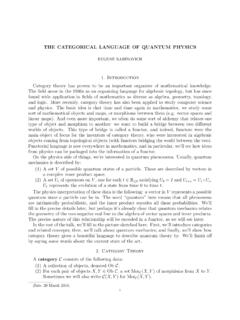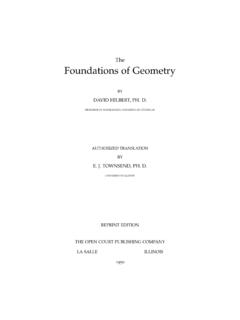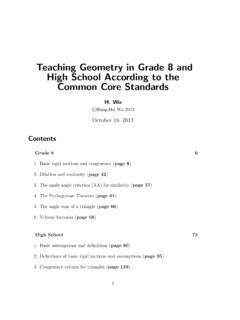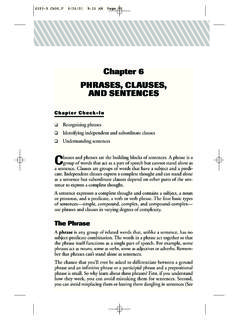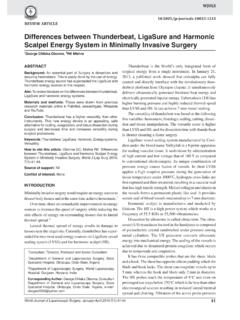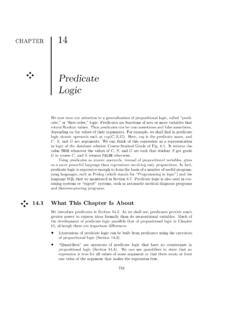Transcription of Math 55: Discrete Mathematics
1 math 55: Discrete MathematicsUC Berkeley, Fall 2011 Homework # 1, due Wedneday, January the propositions The election is decided and Thevotes have been counted, respectively. Express each of these compoundpropositions as English ) p: The election is not (yet) )p q: The election is decided or the votes have been ) p q: The votes have been counted but the election is not (yet) )q p: If the votes are counted then the election is ) q p: The election is not decided unless the votes havebeen ) p q: The votes have not been counted unless the electionhas been decided. This is equivalent to proposition d).g)p q: The election is decided if and only if the votes have ) q ( p q) : The votes have not been counted, or they havebeen counted but the election is not (yet) whether each of these conditional statements is true )If1 + 1 = 3, then unicorns statement is true becauseF Fhas the truth )If1 + 1 = 3, then dogs can statement is true becauseF Fhas the truth )If1 + 1 + 2, then dogs can statement is false becauseT Fhas the truth )If2 + 2 + 4, then1 + 2 = statement is true becauseT Thas the truth each of these propositions in the form pif and only ifq )For you to get anAin this course, it is necessary and sufficientthat you learn how to solve Discrete Mathematics get anAin this course if and only if you learn how to solvediscrete Mathematics )If you read the newspaper every day, you will be informed, will be informed if and only if you read thenewspaper every )
2 It rains if it is a weekend day, and it is a weekend day if it rains if and only it is a weekend day (that s unfortunate indeed).d)You can see the wizard only if the wizard is not in, and the wizardis not in only if you can see can see the wizard if and only if he is not a truth table for((p q) r) qr(p q) rs((p q) r) friends have access to a chat room. Is it possible to determinewho is chatting if the following information is known? Either Kevinor Heather, or both, are chatting. Either Randy or Vijay, but not both,are chatting. If Abby is chatting, so is Randy. Vijay and Kevin are2either both chatting or neither is. If Heather is chatting, then so areAbby and introducing the first letter of the name as an unknown representing that person is chatting . Then the five given statements areK H , R V , A R , V K , H A conjunction of these five propositions is satisfiable, but there isonly one satisfying assignment, namelyA=R=K= true, V=H= 31 other assignments of truth values are inconsistent.
3 One wayto see this is to simply try all 31 possibilities. We conclude thatthe given information suffices to uniquely determine who is chatting:Abby, Randy and Kevin are chatting, while Vijay and Heather are that(p q) (p r)andp (q r)are logically the definition of conditional statements on page 6, using the Com-mutativity Law, the hypothesis is equivalent to (q p) ( p r).By the Associative Law, this is equivalent to ((q p) p) r,and hence to (q ( p p)) r. By the First Idempotent Law, thisis equivalent to (q p) r. Using Commutativity and Associativityagain, we obtain p (q r), and this is precisely the that(p q) ( p r) (q r)is a time around, we find it preferable to construct a truth table:pqp q pr p r(p q) ( p r)q rTTTFTTTTTTTFFFFTTFTFTTTTTFTFFFFFFTTTTTT TFTTTFTTTFFFTTTFTFFFTFTFFFor every occurrence of aTin the second-to-last column, we find aTin the same row in the last column.
4 This means that the conditionalfrom the second-to-last column the last column is always true (T).In conclusion, we have proved theResolutionrule on page a compound proposition involving the propositional variablesp,qandrthat is true whenpandqare true andris false but compound proposition (p q) rhas the desired property,since a conjunction is true if and only if its two constituents are how the solution of a given4 4 Sudoku puzzle can be found bysolving a satisfiability (i, j, n) denote the proposition asserting that the cell in rowiandcolumnjhas the valuen. In analogy to the formulas derived on page33, we assert that every row contains all four numbers 1,2,3 and 4,4 i=14 n=14 j=1p(i, j, n),every column contains all four numbers 1,2,3 and 4,4 j=14 n=14 i=1p(i, j, n),and each of the four 2 2-blocks contains all four numbers 1,2,3 and 4,1 r=01 s=04 n=12 i=12 j=1p(2r+i,2s+j, n).
5 Finally, we need to assert that no cell contains more than one number,and this is done just like in the last bullet on page the truth value of each of these statements if the domainconsists of all real ) x(x3= 1) :This statement is true becausex= 1 satisfiesx3= ) x(x4< x2) :This statement is true becausex= 1/2 satisfiesx4< ) x(( x)2=x2:This statement is true because the square ofa real number is equal to the square of its ) x((2x > x) :This statement is false becausex= 1 does not satistfy 2x > each of these statements into logical expressions using pred-icates, quantifiers and logical (x) denote the predi-cate xis in the correct place , letE(x) denote the predicate xis inexcellent condition , and letT(x) denote the predicate xis a tool .and suppose that the domain consists of all )Something is not in the correct place. x C(x).b)All tools are in the correct place and are in excellent condition.
6 X(T(x) (C(x) E(x)).c)Everything is in the correct place and is in excellent condition. x(C(x) E(x).d)Nothing is in the correct place and is in excellent condition. x (C(x) E(x)).e)One of your tools is not in the correct place, but is in excellentcondition.( x( C(x) E(x)) ) y(( C(y) E(y)) (x=y)). each of these statements using quantifiers. Then form thenegation of the statement so that no negation is to the left of a quan-tifier. Next, express the negation in simple )All dogs have write this statement as x(D(x) F(x)) or x( D(x) F(x)). Its negation is x(D(x) F(x)), and in English ittranslates into There is a dog that does not have fleas .b)There is a horse that can write this statement as x(H(x) A(x)). Its negation is x( H(x) A(x)) or, equivalently, x(H(x) A(x)). InEnglish: no horse can add .c)Every koala can write this statement as x(K(x) C(x)).
7 Similar to a),its negation is x(K(x) C(x)). In English: there is a koalathat cannot climb .d)No monkey can speak write this statement as x(M(x) F(x)) or x( M(x) F(x)). Its negation is x(M(x) F(x)). In English: There isa monkey who can speak )There exists a pig that can swim and catch write this statement as x(P(x) S(x) F(x))). Its negation5is x( P(x) S(x) F(x)) or x(P(x) ( S(x) F(x)).In English: Every pig either can t swim or it can t catch fish . (x, y)be the statement studentxhas been a contestant on quizshowy . Express each of these sentences in terms ofQ(x, y), quan-tifiers, and logical connectives, where the domain forxconsists of allstudents at your school and foryconsists of all quiz shows on )There is a student at your school who has been a contestant on atelevision quiz show. x y Q(x, y).b)No student at your school has ever been a contestant on a televi-sion quiz show.
8 X y Q(x, y).c)There is a student at your school who has been a contestant onJeopardy and on Wheel of Fortune. x(Q(x,Jeopardy) Q(x,Wheel of Fortune)).d)Every television quiz show has had a student from your school asa contestant. y x Q(x, y).e)At least two students from your school have been contestants onJeopardy. x z(x6=z) Q(x,Jeopardy) Q(z,Jeopardy). LetF(x, y)be the statement xcan fooly , where the domain consistsof all people in the world. Use quantifiers to express each of )Everybody can fool Fred. x F(x,Fred)b)Evelyn can fool everybody. y F(Evelyn, y)c)Everybody can fool somebody. x y F(x, y)d)There is no one who can fool everybody. x y F(x, y)e)Everyone can be fooled by somebody. y x F(x, y)f)No one can fool both Fred and Jerry. x(F(x,Fred) F(x,Jerry)g)Nancy can fool exactly two people. y z((y6=z) F(Nancy, y) F(Nancy, z) w((w=y) (w=z) F(Nancy, w)))h)There is exactly one person whom everybody can fool.
9 Y( x F(x, y) ( z(( wF(w, z)) y=z))6i)No one can fool himself or herself. x F(x, x)j)There is someone who can fool exactly one person besides himselfor herself. x y(F(x, y) ( z(F(x, z) y=z)) each of these mathematical statements using predicates , quan-tifiers, logical connectives, and mathematical operators, where the do-main consists of all )The product of two negative integers is positive. m n(((m <0) (n <0)) (mn >0))b)The average of two positive integers is positive. m n(((m >0) (n >0)) (m+n2>0))c)The difference of two negative integers is not necessarily negative. m n((m <0) (n <0) (m n <0))d)The absolute value of the sum of two integers does not exceed thesum of the absolute values of the integers. m n(|m+n| |m|+|n|) rules of inference to show that the hypotheses Randy works hard , If Randy works hard, then he is a dull boy and If Randy is a dullboy, then he will not get the job imply the conclusion Randy will notget the job.
10 By applying Modus Ponens to the first two hypotheses, we infer Randyis a dull boy . We then apply Modus Ponens that that statement andto the third hypothesis to conclude that Randy will not get the job . each of these arguments determine whether the argument is corrector incorrect and explain )Everyone enrolled in the university has lived in a dormitory. Miahas never lived in a dormitory. Therefore, Mia is not enrolled inthe argument is correct. It is an application ofuniversal modus )A convertible car is fun to drive. Isaac s car is not a , Isaac s car is not fun to argument is notcorrect. It is an instance of the fallacy of denying the )Quincy likes all action movies. Quincy likes the movieEight MenOut. Therefore,Eight Men Outis an action argument is not correct. It s a variant of the fallacy ofaffirming the conclusion.
